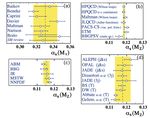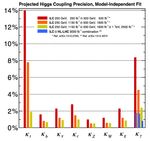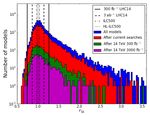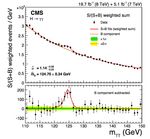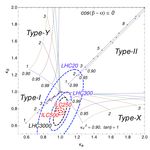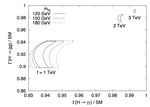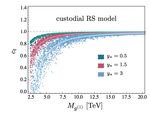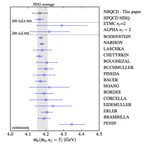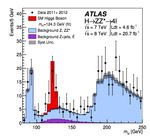The Importance of Lattice QCD for Precision Higgs Boson Measurements - Lepage, Mackenzie, MEP
←
→
Page content transcription
If your browser does not render page correctly, please read the page content below
The Importance of Lattice QCD
for
Precision Higgs Boson
Measurements
M. E. Peskin
Lattice for BSM Physics
LLNL
April 2015
Lepage, Mackenzie, MEP,
arXiv:1404.0319Only four years ago, in the fall of 2011, it was a popular theme for discussion among particle physicists that the Higgs boson did not exist. Searches at the LHC had eliminated most of allowed range for the Higgs boson mass. Only a small corner remained in which the Higgs could hide. Today, the situation could not be more different.
Tests of qualitative properties predicted for the Higgs boson: γγ decay mode ✔ ZZ decay mode ✔ WW decay mode ✔ τ+τ- decay mode ✔ bb decay mode preliminary tt coupling indirectly, through gg spin-parity 0+ ✔
The quantitative measure for used today for Higgs
coupling values is the “signal strength”
(AA ! h)BR(h ! BB)
µ(A, B) =
(SM expectation)I do not think that the case is completely closed that the new particle at 125 GeV is the Higgs boson. But, the evidence is already quite compelling, and the measurements will be qualitatively improved in the new LHC run at 13 TeV. It is time to ask the next level of questions about the properties of the Higgs boson.
If the new particle is the Higgs boson, its properties might still not line up exactly with the predictions of the Standard Model. There may be multiple Higgs doublets. There may be new heavy particles responsible for the form of the Higgs potential. By making precision measurements of the Higgs boson couplings, we can use the Higgs as a tool to prove the existence of these states.
It would seem that is should not be difficult to
determine whether the Higgs sector contains one field
or many, elementary or composite.
However, there is a barrier:
the “Decoupling Theorem” of Howard Haber
If the Higgs sector contains one light boson of mass
mh = 125 GeV
and many heavy particles with minimum mass M ,
the light boson has properties that agree with the SM
predictions up to corrections of order
2 2
mh /MProof: Integrate out the heavy fields. The result is the SM, plus a set of operators of minimum dimension 6. Implication: In most models of an extended Higgs sector or other new particles, the corrections to the Higgs couplings are at the few-% level. Precision measurement is needed to see these corrections. However: The pattern of corrections is different in different schemes for new physics models. There is much to learn if we can see this pattern.
Given the mass of the Higgs boson, the Standard Model
makes a precise set of predictions for the couplings.
These should be considered as reference values for
precision measurements.
For a Higgs boson of mass 125 GeV, the prediction for the
total width is h = 4.1 MeV
The branching fractions are predicted to be
bb 58% ⌧ +⌧ 6.3% 0.23%
⇤
WW 21% cc 2.9% Z 0.15%
gg 8.6% ZZ ⇤ 2.6% µ+ µ 0.02%
Many decay modes of the Higgs will eventually be visible,
and measurable. F. Gianotti: “Thank you, Nature.”Measurements at the International Linear Collider
(ILC) in
+ +
e e ! Zh e e ! ⌫⌫h
will allow model-independent determination of
the individual, absolutely normalized, partial
widths for Higgs decay into these modes at the 1%
level of accuracy or better.The study of the deviations from these predictions is guided by the idea that each Higgs coupling has its own personality and is guided by different types of new physics. This is something of a caricature, but, still, a useful one. fermion couplings - multiple Higgs doublets gauge boson couplings - Higgs singlets, composite Higgs γγ, gg couplings - heavy vectorlike particles tt coupling - top compositeness hhh coupling (large deviations) - baryogenesis
2 Higgs
doublet
models
Kanemura, Tsumura, Yagyu, Yokoya(h ! bb) in a large collection of SUSY models
Cahill-Rowley, Hewett, Ismail, RizzoLittlest Higgs model
Han, Logan, McElrath, WangMalm, Neubert, Schmell
Putting all of these effects together, we find patterns
of deviations from the SM predictions that are
different for different schemes of new physics.
For example:
SUSY Composite Higgs
Kanemura, Tsumura, Yagyu, YokoyaThis is a compelling program, but it requires new and very accurate Standard Model computatons. What we will measure are the absolute values of Higgs partial widths. In order to detect a deviation from the Standard Model expectation, we must compare these to Standard Model reference values. Those values must then be computed to better than 1% accuracy. It has been questioned in the literature whether this is possible, especially for (h ! bb) , for which a very accurate value of the b quark mass is needed.
There are two types of contributions to the theoretical
error on SM predictions:
error from uncalculated orders of perturbation theory
error from uncertainty in input parameters ( mb , ↵s )
I will quote uncertainties in terms of quantities
1 (h ! AA)
A =
2 (h ! AA)The partial widths to WW, ZZ also depend strongly on the mass of the Higgs boson: This is a 0.2% uncertainty for mh = 30 MeV . This is the primary motivation (in my opinion) for a very accurate Higgs mass measurement.
For the theoretical errors, the situation is quite good.
These uncertainties in A are currently
0.1% for Higgs couplings to quarks
2 % for Higgs couplings to gg
1 % for Higgs couplings to WW, ZZ
1 % for Higgs coupling to
Among the most impressive theoretical efforts are
4
Baikov, Chetyrkin, Kuhn: g(hbb) to O(↵s )
Baikov, Chetyrkin,
4
Schreck and Steinhauser: g(hgg) to O(↵ s)
Actis, Passarino, Sturm, Uccirati: g(hgg) to O(↵↵s )
Improvement of the current results to 0.1% accuracy is
possible, though it will require dedicated effort.Now turn to parametric uncertainties. The strongest
dependences are those on mb , mc , ↵s .
Most of the parametric dependence comes from
ghAA ⇠ mA
The factors of mass must be defined carefully. The
perturbation theory is free of large logarithms for
2 2
mA ! mA (M S, µ = mh )
This must be determined by parameter values
measured at lower energies. We choose as our
parameters the M S values
mb (10.0 GeV) , mc (3.0 GeV) , ↵s (mZ )Formulae for running M S masses are known to 4 loops.
Using RunDec (Chetyrkin-Kuhn-Steinhauser) or the
private code of HPQCD, we find
Note that the coefficients are much larger if the quark
masses are evaluated at lower scales, or at scales that
depend on the quark mass. For example,
mb (mh ) = 1.19 · mb (mb ) ( 0.69) · ↵s (mZ )Combining this dependence with that from the perturbation theory, we find The coefficients are of order 1. Thus, we still need the input parameters at the 0.1% level.
We claim that this level of precision can be achieved by lattice QCD. Lattice QCD already gives the highest-precision measurements of ↵s and measurements of precision comparable to the state of the art for heavy quark masses.
most recent PDG compilation of ↵s measurements The PDG value, dominated by lattice QCD, is ↵s = 0.1185 (6) (0.5%)
mb (mb ; M S)
The current best
determinations of
from lattice QCD
calculations of the ⌥
spectrum give
4.166 (43)
4.164 (23)
Comparable results
from QCD sum rules are
4.171 (9)
4.177 (11)
4.163 (16)
From the global fit to B decay distributions using HQET
(HFAG): 4.194 (43)I will now describe one strategy for reaching high precision using lattice QCD (HPQCD group): Study a 2-point correlation function Take moments, and extrapolate these to the continuum limit Use f⇡ , m(⌘c ), m(⌘b ) to set the scale of masses for the lattice spacing. G2n depends on off-shell masses at Q ⇠ 2mQ .
This gives the continuum values of QCD sum rules. Analyze these using continuum QCD formulae with M S subtraction. This evades the need for high order QCD perturbation theory. The perturbation expansions for the moments 2n 10 are known to 3rd order in QCD perturbation theory. Chetyrkin-Kuhn-Sturm, Boughezal-Czakon-Schutzmaier, Maier-Maierhofer-Marquand-Smirnov
The method is similar to the direct use of experimental
data, except that it is systematically improvable.
Fermilab and JLab clustersForeseen improvements:
LS - decrease lattice spacing from 0.045 fm to 0.03 fm
2
LS - decrease lattice spacing from 0.045 fm to 0.023 fm
PT - compute one more order in QCD perturbation
theory
ST - increase statistics by a factor 100
2
LS requires a factor 100 increase in computing power.fractional uncertainties in % Lepage-Mackenzie
Other, independent, methods are available to measure ↵s in a manner uncorrelated with heavy quark masses, and to measure those masses using different techniques.
One of the most powerful ways to search for physics beyond the Standard Model will be to search for deviations in the Higgs boson couplings from their SM reference values. The bread-and-butter program of Lattice QCD, improving the precision of our knowledge of quark masses and the QCD coupling, is essential input for this comparison. Please devote the computing resources needed to reach the goals for precision QCD that this program requires.
You can also read
